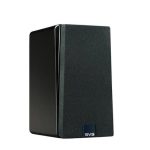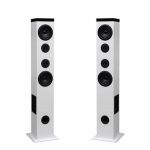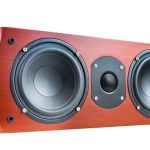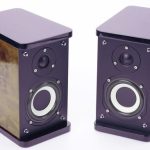Do you need loudspeakers for your home audio system? Whether you choose compact, big or small loudspeakers, the aim is to improve your home audio so that you can derive more enjoyment from the entertainment system.
You could also be an installer seeking a deeper understanding of home loudspeakers so that you can serve your customers better.
Floorstanding and bookshelf speakers are the most common options for home loudspeakers. Which is better between floorstanding and bookshelf speakers?
Choosing one type over the other is not easy. This is why the above question traverses many forums and sites that deal with audio systems.
Are you also asking this question?
We won’t promise to give you a conclusive answer (because the answer does not exist). What we do promise is an objective breakdown of the differences between these two types of loudspeakers.
This ‘floorstanding vs. bookshelf speakers’ guide contains detailed explanations of the performance attributes and application requirements of each speaker type. As you read along, you will understand why either of the two loudspeakers can be desirable to different home audio enthusiasts.
Let’s kick off our discussion with a general overview of each speaker’s advantage and disadvantages. This overview will help if you are pressed for time and want to head fast to our guide on choosing the best floorstanding speakers or the best bookshelf speakers. If you have a few more minutes, however, stick through as we tear down the main differences between these speakers.
Pros and Cons of Floorstanding speakers
Pros
- Reproduces multiple frequencies
- May include a subwoofer
- Does not need a stand or table
Cons
- They take up more space
- They are more expensive than bookshelf speakers
Pros and Cons of Bookshelf speakers
Pros
- Smaller size that takes less space compared to floorstanders
- Easily fit in the home décor
- Generally cheaper than floorstanding speakers
Cons
- Lack deep bass unless you couple them with a sub
- Need a stand or table to rest on
Factors to consider when choosing between floorstanding and bookshelf speakers
The thing is, we cannot say that one speaker is better for you. That is your call. Considering the following factors will help you make the right call.
i. Desired sound
You are looking for a certain kind of sound. That sound might be characterized by high-quality mids/highs or by big, loud bass.
Do you like live concerts, where sound presentations feels as if coming from a big wall of sound placed in front of you? If yes, then floorstanding speakers might be the better option. When these loudspeakers are placed correctly in your entertainment room, they create a marvelous three-dimensional soundstage, akin to bringing live performance experience right to your home.
If, on the other hand, you desire better quality mids and high frequencies, bookshelf speakers can give you that. Most of them are designed with 2-way configurations (a tweeter and mid-range driver). A bookshelf performs better in delivering moderately loud, more compact audio.
ii. Bass extension
Adding a sub to your system can take the bass load off a bookshelf speaker. The result is a significant improvement in the bookshelf’s midrange performance. However, floorstanding speakers perform much better with regard to bass management. One of the reasons for this is the bigger cabinet, which provides the speaker with greater capability for bass extension. Therefore, you do not need to buy a sub separately once you have a floorstander in the house.
iii. Sensitivity
Sensitivity in sound reproduction implies the efficiency of a driver in producing sound. When all other factors are kept constant, floorstanding speakers are more efficient than bookshelfs. This means, with the same amount of power, the floorstander will produce a higher volume than the comparable bookshelf.
How does this information bit help you?
If you are concerned about amplifier power or the volume you desire, you will better off going with a floorstanding speaker. Otherwise, a bookshelf is just fine if you have a powerful amplifier, such that power supply is not an issue, or if you are okay with moderate sound volume.
iv. Sound imaging and accuracy
Accuracy and imaging constitute a vital aspect of sound reproduction. Sound imaging is the ability to of a speaker to stage sounds, that is, present them in imaginary fixed locations before the audience.
The factors to consider in this regard are cabinet resonance and baffle interaction.
Cabinet resonance: As the tweeter and woofer move, the speaker cabinet to which these components are affixed vibrates. Cabinet resonance is the undesirable vibration of the cabinet when sound is being delivered by sound drivers. It affects the purity or accuracy of sound waves. This effect is usually audible as muddiness or blurring of sound. Sound waves can lose clarity and transient speed, and imaging is vague.
While sound engineers try their best to minimize cabinet resonance, bigger speakers are more prone to resonance than smaller speakers. Thus, you are more likely to experience a higher degree of undesirable vibrations with a floorstanding speaker than with a bookshelf. Most bookshelf speakers from top brands will exhibit clearer, more accurate sound with better imaging than comparable floorstanders.
Baffle interaction: The front-facing panel of a speaker (where the drivers are mounted) is called the baffle. It can transmit some of the sound waves emitted by the speakers to the back of the cabinet, which affects the frequency response of the speaker. Larger baffles are associated with larger negative impacts. As such, the disadvantage falls on floorstanding speakers because of their big baffles. Bookshelf speakers generally have a better frequency response with better sound imaging.
v. Space considerations
In the anxiety of choosing a speaker for your home theater, you can quickly conclude that bookshelf speakers are smaller and thus will take smaller spaces compared to floorstanding speakers. We indicated this in our pros and cons table, but it’s important to understand more about the space considerations of each speaker.
One of the crucial things to note about bookshelfs is that you need to mount the speaker on a stand for it to give its best performance. Now, a stand occupies almost the same amount of floor space as the base of a floorstander. Thus, there are no savings on floor space if you choose to use a bookshelf with a stand.
Here is how you can save significant room space with bookshelf speakers: You can place the speaker in a bookshelf (as the name suggests) or wall mount them if you want to use every bit of floor space with other things. Note, however, that shelf and on-wall placement will affect the speaker’s sound performance. When a speaker is placed too close to a wall, sounds reflected by the wall result in less accurate audio.
vi. Décor
Closely related with speaker size and placement is how the speaker fits with the room’s décor. Where you place the speaker will influence the décor of your room. Generally, bookshelf speakers can be fitted in various locations to complement the room’s décor.
Some bookshelf speakers can also be hidden under the couch or somewhere less visible. The size of floorstanding speakers doesn’t leave you with much freedom over where to place the speaker. Thus, you may find it harder to play with your décor options when using floorstanders than when using bookshelf speakers. The need to pull the speakers away from walls (at least 2 feet away) further intensifies the challenge of placing floorstanding speakers in a décor-complementary position.
Unless you have massive floor space, you should be concerned about where to place your new speaker. Some people hide floorstanding speakers using a false wall designed with acoustic fabric (a great idea for home theater). Manufacturers have started being keen on style as they build speakers, so you might actually find a floorstander that complements your décor.
vii. Budget
Money is always a consideration when making a considerable investment in entertainment systems. For us to consider this factor objectively, we need to ditch for a moment the simplistic assumption that bookshelf speakers are cheaper than floorstanders.
You want to spend your money on a speaker that will give you the improvement you are looking for. To realize the ultimate potential of a bookshelf, you must have it mounted on a stand. The cost of a good speaker stand could be anywhere between 20% and 30% of the speaker’s price. The total cost of the speaker and its stand may be close to the price of a comparable floorstanding speaker. This consideration leads us to an objective conclusion: Bookshelf speakers are not always cheaper. Also, you should not choose between the two speaker types on the basis of cost alone. It is better to consider what you want first and then choose the home theater speaker that meets your needs within your budget limits.
We have explored the most important considerations when doing the comparison of floorstanding vs. bookshelf speakers. These factors include the desired type of sound, speaker efficiency, sound accuracy and imaging, bass management, space and decor considerations, and cost. Floorstanding speakers are preferred when bass and higher volume are the key concerns while bookshelfs appear more appropriate to users who prioritize placement flexibility and sound accuracy and imaging.
Michael Evanchuk is a San Francisco-based sound engineer with 20 years’ experience installing, troubleshooting, and repairing commercial, automotive, and household sound equipment. Evanchuk owns an auto stereo center, where he offers highly competitive car audio installation and repair services. He has written dozens of articles on different sound engineering topics, all of which have been published in leading journals, blogs, and websites.





